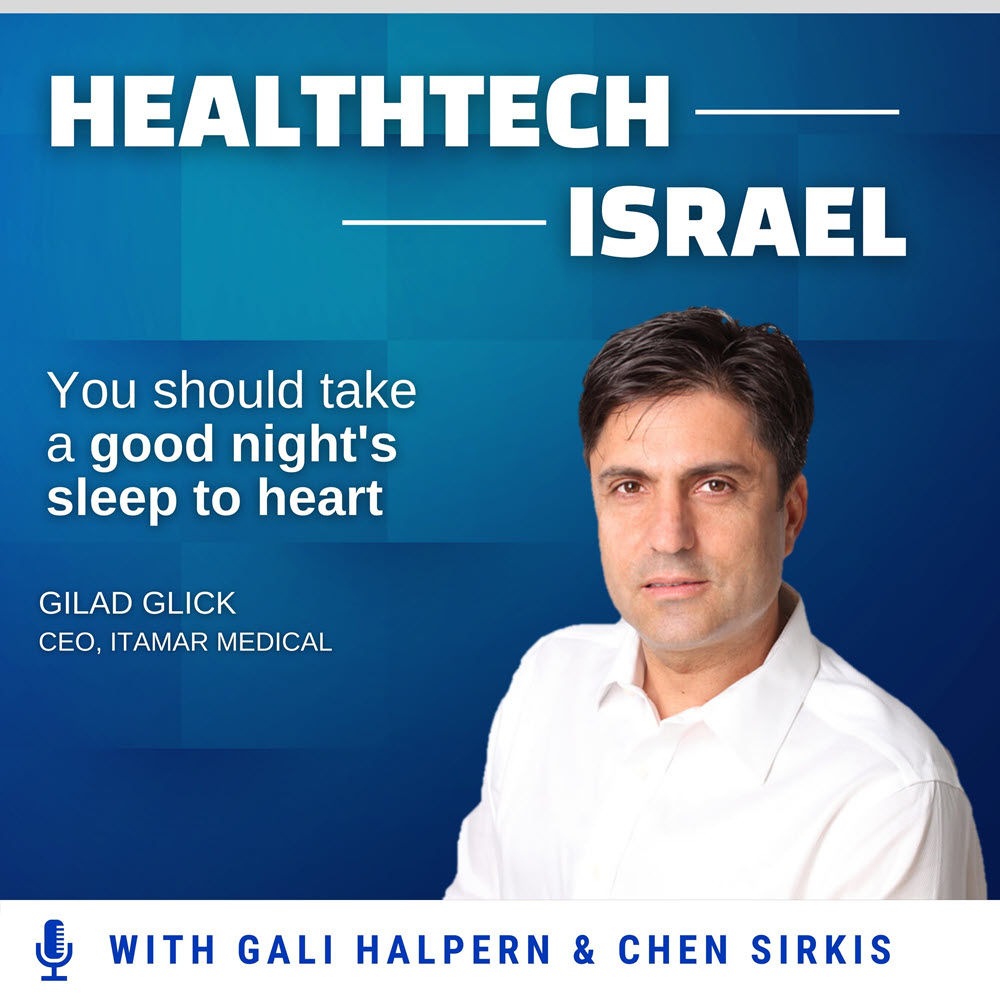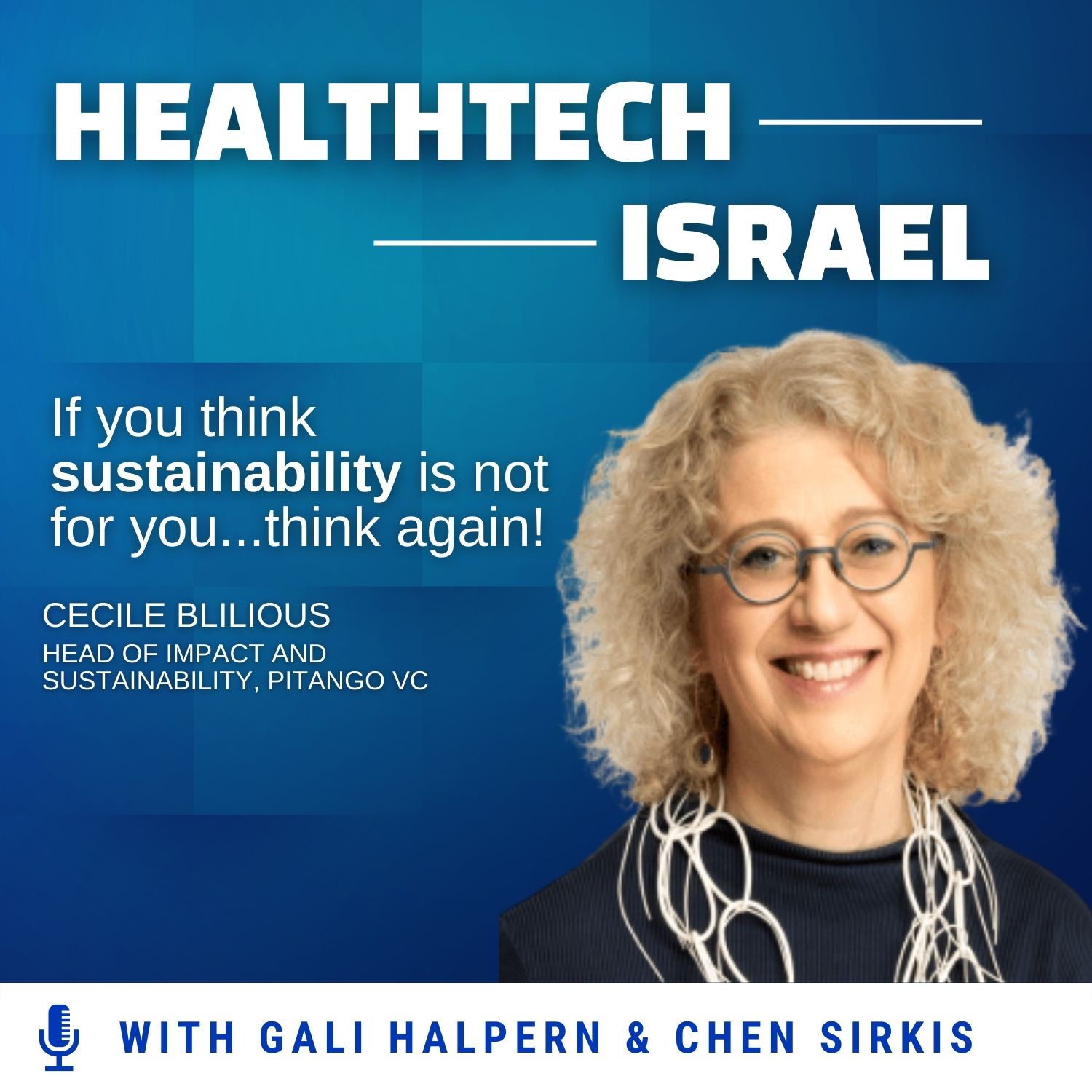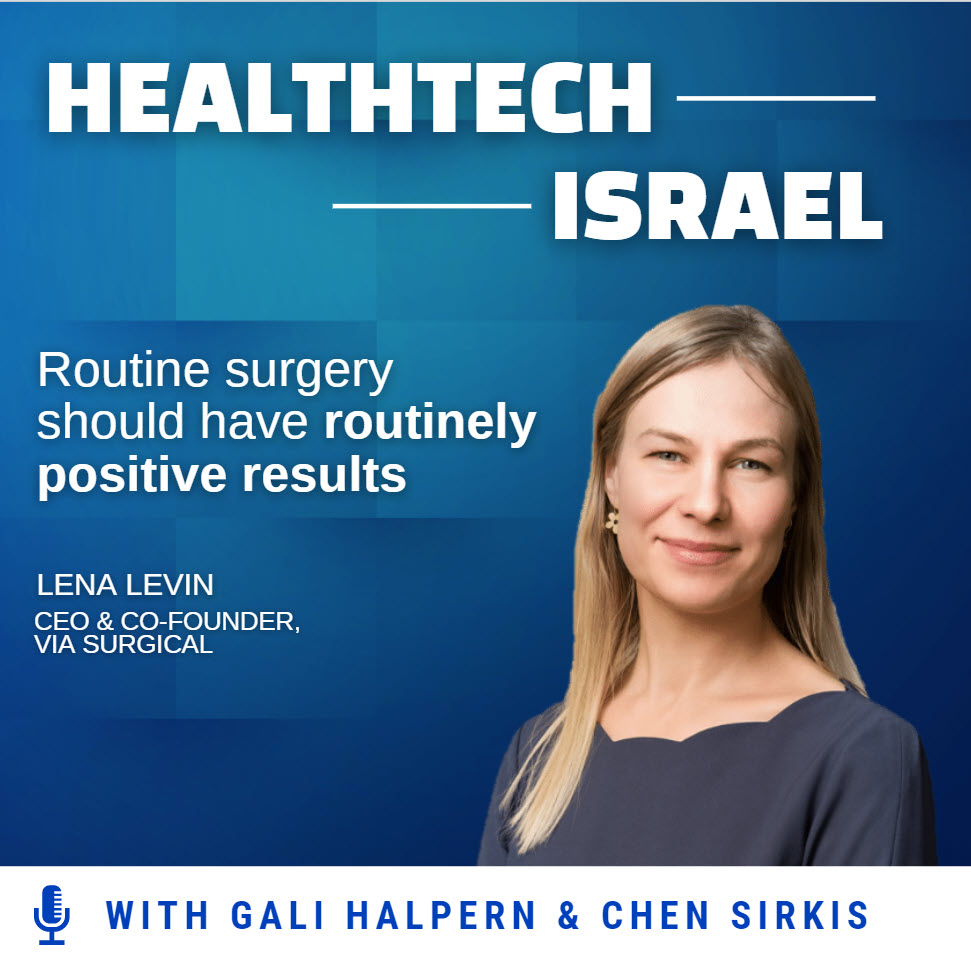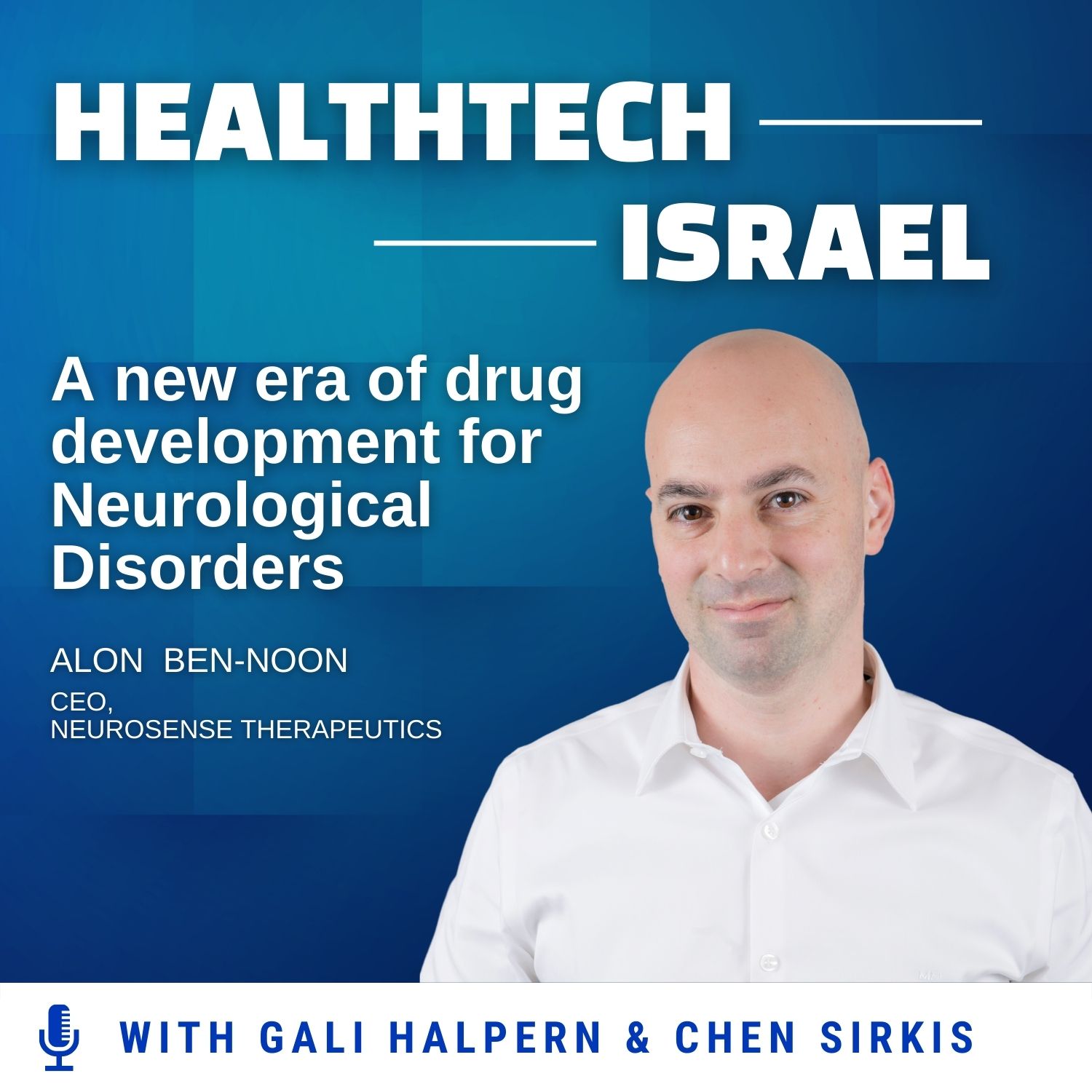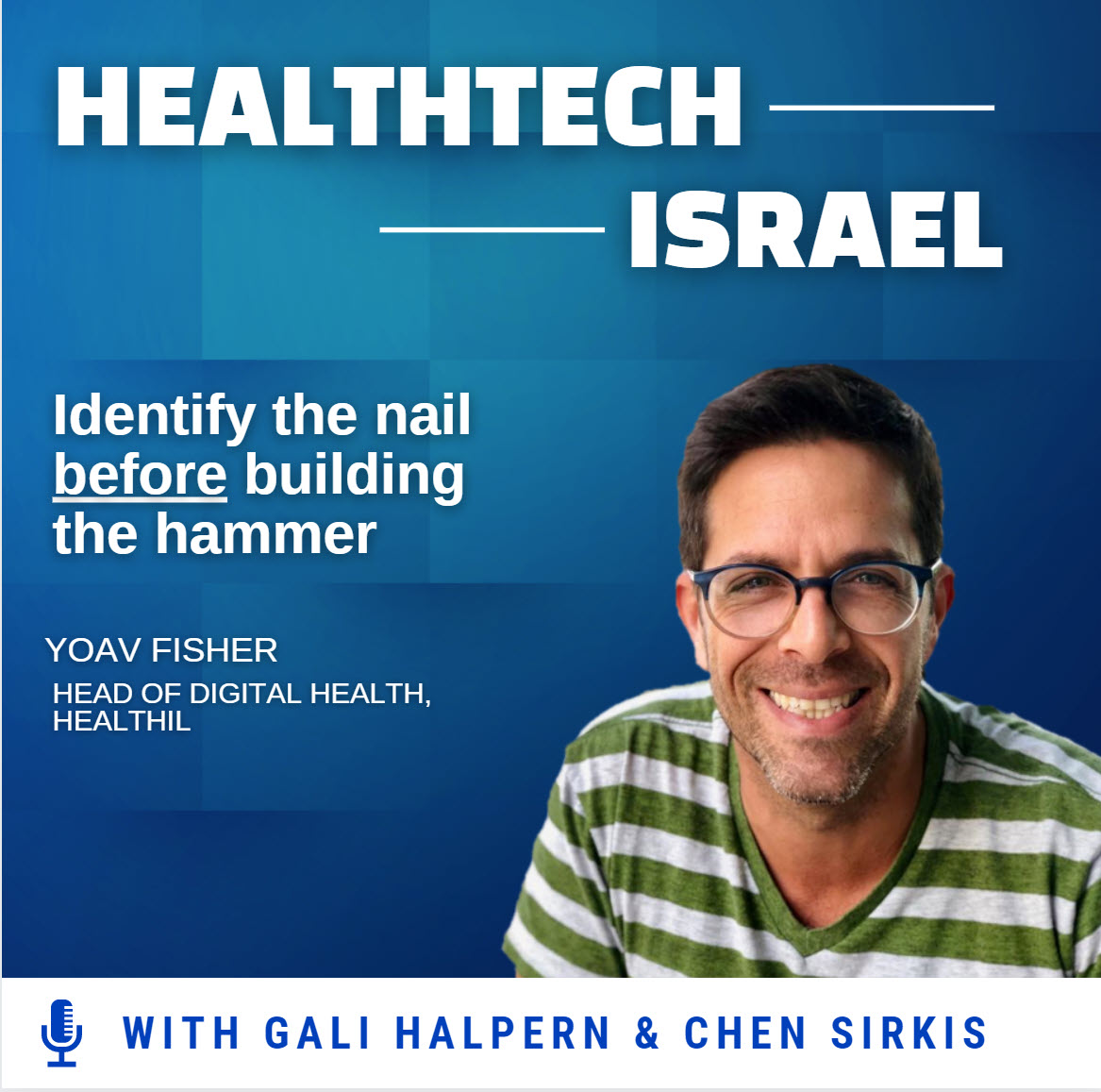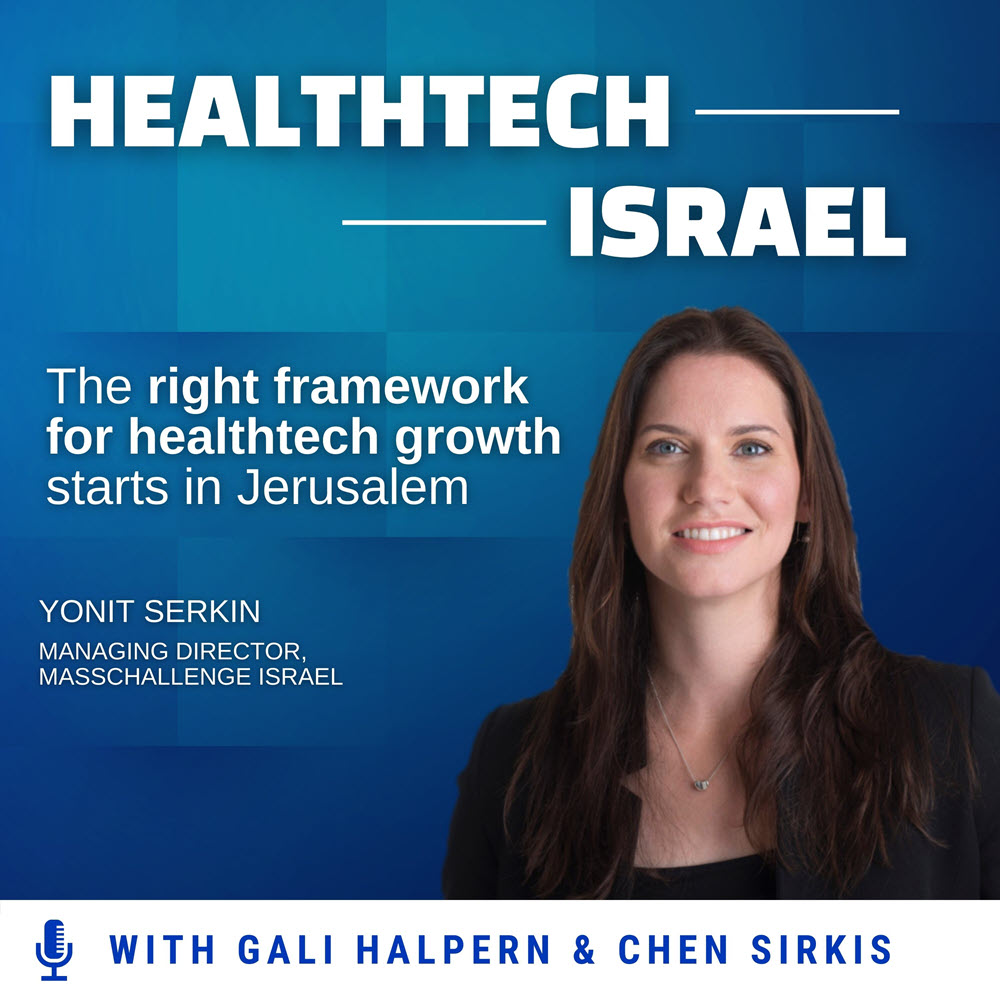Galit Zuckerman-Stark
CEO, medasense
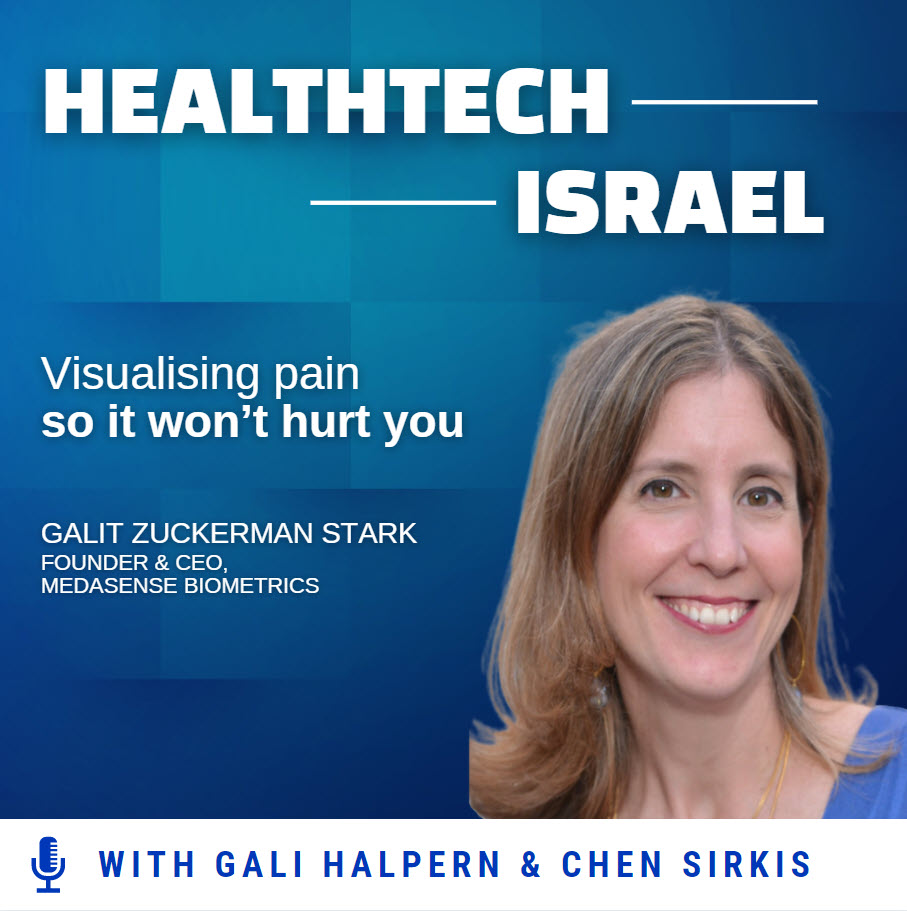
Galit Zuckerman-Stark is CEO of MedaSense, developer of a unique technology that objectively monitors and quantifies the patient’s pain response level using artificial intelligence algorithms and a proprietary noninvasive sensor platform.
Show Notes
In this episode, we are speaking with Galit Zuckerman Stark. Galit is the CEO and cofounder of Medasense. Medasense is NOL technology, enables clinician to personalize pain management, optimize treatment and avoid overmedication. All this in it with a noninvasive sensor platform and AI technology.
Galit is also an alumna of the Haman Talpiot program.
Interview Transcription (mild edits)
Your background is actually nonmedical and even technical. What brought you to the medic field and to becoming the CEO of a breakthrough product in what is actually a very difficult market to operate in?
Galit Zuckerman: I started my career at the high-tech industry at Haman Talpiot. Immediately, I went to learn Computer Engineering. And I was in the high-tech industry starting from communication industry, cyber and then semiconductors. At a certain point, after about ten years in the industry, I felt that I need to do a shift n my career. Actually, I made two shifts. One of them was to understand that I want to start my company. I wanted to build a company the way that I believe it should look like and be like. And at that same time, I thought to myself that if already I'm doing the primary and devoting myself to starting a new startup, maybe the startup can have an impact on the world. And that medical field seemed like the right direction. And specifically, when I was exposed to the issue of pain, helping patients suffer less from pain or from the pain treatment for me, was a good and still is a great mission. Obviously, it wasn't immediate. It took some time. It's really about the curiosity and the need to do something that is meaningful.
Why pain? There has to be some personal connection there?
Galit Zuckerman: It's a coincidence of few things or not coincidence. First, my mother is a nurse in the operating room. the coincidence was when I heard about people who feel pain during surgery. And then I had my mother as a reference to ask 'Why?' People are asleep, why should they feel pain during surgery? My mother connected me to pain specialists. And I was amazed to see that on one hand, I was working on beautiful sophisticated AI technologies in the nonmedical field. And just across the street, they were using smiley faces to assess pain. I said that I probably can contribute even without having seven years of medical background or studying medicines, to contribute to this world and to help make it a little bit better. It was not the only way that made me arrive to the field of pain and connect to the leading pain specialist here in Israel, Professor Elon Eisenberg and [04:56 - unintelligibly] actually brought me in, opened the door for me and to start the activity there.
So what you are doing actually is offering an objective measure for pain. Why is there a need for an objective measurement of pain?
First let's start with the basic thing. If you want to improve something, you first need to quantify it. How can you improve something if you don't know where you are? Now, the subjective measures that are today, it is what we have. But there is large variance between people. And its variance between whether we feel pain differently, whether we express pain differently because of cultural behavior. Whether we have different agendas. Maybe we don't want to make too much noise out of this pain, or maybe we want to make a lot of noise out of the pain. all of these elements really attenuate or change the reliability of the subjective pain. And one physician told me that, asking a patient what his pain level is like asking the patient what his blood pressure level. Not exactly alike, obviously, it's a little bit different. But this is how they feel. Again, both the clinician and also the patients. And this is when the patient can communicate. And there are many cases that they cannot even say, they will use those smiley faces or use the 0-10 scale. When they're in an operating room of critical care, palliative care, babies, all these cases, is actually the subjective assessment of the care provider. In all those cases, you really need to give something that is more objective and we see the consequences. Most of the people get too much or too little pain treatment.
(Gali) Can you go back to 10-11 years ago and share what you were thinking your product process was going to be? And then go to, where you are now and what your product is?
Galit Zuckerman: First, let's say the mission and the vision hasn't changed. It's still helping patients wherever they are; to better express their pain situation in order to personalize and optimize the pain treatment, to improve outcome, to improve their pain and improve their suffering either from pain or for pain treatment.
The path for this process was to first understand that pain is a big world. And there are many different scenarios of pain and situations of pain and treatments of pain. And then, you need to pick one of them to start with and look at the bigger picture. And when we were starting, after we did our first trial just to show that it works. compare it with experimental pain, people saying how much pain they feel when we inflicted pain. And people saying, how much pain they felt and we managed to develop technology that correlates with that. We ask ourselves, 'Where first we are really, really needed and what first should we start with?'. And again, every segment was people were crying, we need it now. Like, give us this; this is the 'something'. And as you said, once you see the smiley faces, you could ... I wouldn't say, but let's say you're not the first, you’re the only one reacted the way you did. But then we realized that maybe it would be better to start with the people who are not, who are not able to communicate.
Because let's say, whatever we have to say about the smiley faces, it at least gives us a tool to express something. Maybe the scores are not good, but at least we can say we're in pain, or we're not in pain. This is something that we really know what to do. It's just the numbers that sometimes don't reflect what you need. With that, we said, 'Okay, let's start with the noncommunicating patients’. And then we said, 'Let's go and start at the high end in operating rooms, ICUs or also physicians are used to getting the numbers and score indexes; and to treat based out solutions on that. this is what we did when we were doing big market research; we looked at all the segments. This is what made us go to that specific market, of noncommunicating patients in critical care in the operating room as the first segment. And this is where we are commercialized today.
(Chen) When I worked at a venture capital firm, Medica Venture Partners more than 20 years ago, I came across a company called Algodyne who claimed they give an objective measurement of pain. At that time, the feeling of the fund was that nobody will pay for it. So obviously, some things have changed in the last 10 or 15 years. What do you think are the main things that changed in the industry that allowed you to sell products and raise significant amounts of capital from investors?
Galit Zuckerman: first through the years, there was a shift or understanding what is needed in order to improve pain management. it started somewhere there in 2001, something like that, where pain become like the fifth vital sign. physicians, nurses, clinician head or NP still had to measure; to ask how much pain you felt as part of the treatment. So that was one milestone. And then especially in the US, because people reported high level of pain started to give medication. And it happened to be the most effective medication that was back then and is still I think the most powerful one of all the opiates; the different elements of opioids So then something like 10 years later, they realize that it went out of control. The opioid epidemic is all over. People, normal people, had pain and became painkiller opioid addicted. The last year more people died from opioids than in the Vietnam War.
it became a huge issue. And then, they realize that you can just give more. Obviously, people who have suffered from pain, you cannot just give less. You really need to know what amount to give. And this is where they understand that there is something missing in terms of the tools that they were using. I'm starting to look for objective tools to measure pain. And it's like it spans from the US also Australia, UK. And it's not as worse as it is in the US, but you see the signs there, depends on the situation in other areas. that was a major understanding that maybe we need better tools to address that.
And that also inflicted on the operating room and critical care, where they need to treat pain. And then, not necessarily, those patients who receive opiates for short-term will become addicts. Obviously, over time, they realize that there is an increase. Now, today, they say that there is like, ... Chen, if you suffer 10% is more time at the operation after the operating room from severe pain.
There is a chance, 30% chance, that you will be likely higher to be addicted to opioids later. there is correlation. And this understanding and shift went to the acute care, to the short-term care of pain. And then again, the knowledge and understanding, the realization. And they understand that whatever they're doing right now is not good enough and still half the patient wakes up from severe pain.
And about 12, currently, are suffering from severe adverse effects from the physician with treating directly the patient. this is kind of a shift that they went through, not being aware of that, being aware of the pain and then being aware of overmedication. And now trying to find tools to balance between the two.
Can you explain a little bit about how the technology itself works?
Galit Zuckerman: The concept is that we're looking on what we call the physiological pain. we're looking on how the body reacts to pain. the basic behavior of the body is when the body experiences pain whether we are aware of it or not. This is at very low levels pain. There is need for our bodies to be conscious of that. It simply reacts. The mechanism that is called fight-or-flight. It saves us; it is a survival mode. when our body experiences pain, our heart rate goes up, blood pressure increases, we start to sweat, we may have tears; and obviously our respiration and breathing will be different. all of that is happening naturally.
What we do is listen to this. That's a natural response and the difference between what was done till today. In the operating room, they are looking at heart rate and blood pressure, because this is the only way for a physician to know whether the body is experiencing pain or not. But they are not accurate enough.
What we're looking at is the combination of many different physiological responses, and looking for pattern. the idea is that heart rate can go up for many different reasons. But a combination of heart rate, blood pressure, sweating, respiration, etc., and a very specific pattern probably won't repeat as if it is pain response.
this is what we're doing. Using AI, artificial intelligence, specifically machine learning algorithm. And then, at the development stage we teach the system. We give examples of different levels of pain, different levels of medication, and it catches those patterns. the algorithm eventually finds the patterns and reports its presence in a scale of 0 to 100.
let’s say 100 is an extreme physiological response to pain. Usually we don't get to there. And 0 is like no response; totally no response. And we see that if there is a lot of medication used or an effective epidural or local anesthesia. And we see that al for example, in brain dead patients; it's like there is no response there. patients are kept at a number between 10 to 25: there is a physiological response to pain, which you expect when they are operating on a patient. But not too much, not too little.
And is there a personalization? Does it learn per person? I know from personal experience that the pain threshold is different between people.
Galit Zuckerman: Yes. It’s indeed, calibrating at the beginning. Because even if you put aside the pain, each one of us start from a different physiological level, that is not necessarily pain. Obviously, my heart rate now is probably higher than yours, especially when I speak.
it takes a baseline and then it looks for changes. its each one compares to their own baseline. it changes comparing to a baseline that takes part of the subjectivity or the difference between people and looks on the individual response.
Your first market is into the operating room. When a patient receives anesthesia, it's actually made out of two different medications. One is to get the person to sleep. Number two is to manage the levels of pain. Are you only addressing the pain component? Or are you helping the anesthesiologist manage both types of medications?
Gali Zuckerman: We're looking at what's needed; there are those two components. Actually, there is an additional one, paralysis; so that's what you want during the surgery. we are looking at the pain component, which is again a physiological response for the consciousness or hypnosis level. There are tools in the market that measure brain activity. when you're asleep, you're expecting a certain brain activity.
why don't we measure another productive measure is measuring the brain activity or sleep or hypnosis and we are looking at how the body reacts to pain. two different technologies. Obviously, there is even some synergy between them because the medication they also have some synergy etc. But two different products to address two different medications that are used during the surgery; during the anesthesia.
Many companies especially in Europe go to local specialized distributors in different countries. But you decided to work with a very large multinational company, Medtronic. How did that come about? And why did you decide that working with such a large company is better for you rather than look for localized specialist distributors?
Galit Zuckerman: We actually we have both. In Europe, we have the strategic Medtronic as a strategic partner, selling our product under the Medasense brand name. And in other territories, we have a specialty distributor. Medtronic didn’t get in the beginning all of Europe, but a portion of Europe. Medtronic has a product that measures hypnosis or measure the sleep during surgery. there is such a synergy between those two products. We said, obviously, they know how to sell brain or hypnosis monitor so they will probably will know how to sell the pain monitor.
And it came from the perspective that when you deal with large company for better or worse, but you still you enjoy it. When there is a step, it's a major step. We had an opportunity to do that. And in a certain way, who would say no.
But again, obviously there are pros and cons to working with major strategic partner. It takes time and and resources and even to start to begin with. It seems what I would say that probably with strategic partners, it's a slow start. But eventually, once you know, it's like an elephant.
But every step is a big step once it moves. Comparing two distributors that are faster to react; when we see that they are faster to move, but the steps are smaller. Now we see the balance. We think it's a good balance between Europe where we have one player ... And again, managing Europe it’s like we say Europe, but it's like different countries; totally different countries. Not having 15 different distributors to manage each of the country, there is some advantage to that. And in other places, we are working with local specialty distributors doing your [26:05 - unintelligibly.]
It's quite unusual for an Israeli company to start with Europe. Why did you decide to begin with Europe? You just explained how complex it is, and every country having its own regulatory and reimbursement path. Why did you decide to go to Europe first?
Galit Zuckerman: I think we started with CE and FDA discussions the same time. We got a CE mark and the FDA, we're still in the process. Once you get the approval to this significant market, we started obviously, selling in this market. And now, I must say that in Europe there are difficulties because there are different countries. And again, the only thing that is common is the CE Mark. The rest is I'd say each one is different. But what we realize also is that Europe is more advanced in terms of anesthesia, in terms of both technology and both the regiment. The way they treat the patients during surgery. And it's also probably because of regulatory that they have a lot of technology ... There are medications that took years until they were approved in the US.
In Europe, they are much more advanced. We enjoy it in a way to work with the most leading physicians that are worldwide, but in terms of different way of treating pain during surgeries. And we have all these different methodologies to know and to evaluate the technology and to test it and to improve that.
In a way, to start with Europe was good. And it's much easier Europe to Israel, in terms of traveling and we did a lot of traveling, and now we have another team in Europe. We enjoy the fact that there are only 3 to 5 hours of flight compared to the US.
So again, it's the circumstances. But eventually, we realized that there is also a positive thing and advantage to the fact that we started with Europe. And that the experience of different situations and scenarios and treatments to evaluate and check and improve our technology.
One of the main challenges when working with distributors, in your case Medtronic is a distributor a partner, is that you may lose touch with the market. They will be there walking the hospital floors, doing the sales, getting the feedback. How do you make sure that this doesn't happen in your case, especially in light of the fact that the last year there has hardly been traveling?
Galit Zuckerman: First about the question How to in a certain way how to still be filled in what's going on. in a way, similarly Medtronic and the other distributer, we communicate at all the different levels. From the sales rep and clinical specialists in the field, to the leadership. Whether in Europe or whether in the US. We communicate at all those different levels, and it's very important.
Because again, if you just communicate at the high level, you have no idea what's going on in the market. But again, in terms of the COVID, I think it has different effects on big companies compared to small companies. But sometimes it's for ... Again, companies close for the better and companies close for good.
You know, certain distributors didn't manage well and just disappeared or they were acquired if they didn't have their financial means. On the other hand, you have a big company and they have all the regulations. In a certain way, their activity can be low through the COVID. again, there are pros and cons to different situations.
And when I think about companies, they really need to ask themselves comparing to the situation, what are the opportunities and what is the best for them. if yes, for a company, it's good to start from a small scale and to grow to a larger scale. I must say that at the beginning, I said, this distribution is going to kill us. The amount of investment that was required from us it was unexpected.
And the people that transition from being a very startup, prototype type of level product to setting all the standard, the strategy, it's a huge process and it's a lot of money. And you need to go through that. And you start everything doing it in a certain way. companies and need to take that into account when starting a big company.
But again, the reward maybe much higher than working in small steps you become mature. Maturity increases from a toddler then you become a senior high school graduate. Companies needs to take that into account when they are gaining into this advantage. And taking the time, especially the time. It's not everything that year, we have a new version here.
Now it works great taking into account between half year to one year. Sometimes until it's with your customers. you have a great marketing tool. Until it's, "We are now the ICU!" Wait, wait, wait, wait, it takes ... You need to go and prepare and process and educate. the process is much isn't. Again, process means resource and time; time is money. companies need to take that into account.
You pointed out some very important things about managing the company in a time like that of transitioning from a product company to a commercial one. Who helped you during that process? How did you manage your stakeholders?
Galit Zuckerman: I think first, like transparency and working together, like being at the same decision, same process, understanding. And understanding where they aren't any surprises. It's like you thought and you were told, and you were sent and you were signed. And then, you weren't coming three months later. Being transparent when in terms of the board and investor being part of it. And again, to the level that they need to know and they don't need that. There are so many details. But knowing what's going on and knowing again, if there are delays and what's the risks compared to opportunities that's very important.
In terms of the caliber of the people. We have this process in terms of the team. We hired people who have experience with working with companies. I'm talking about my leadership team. the CFO actually worked at Oridion that was acquired by Covidien. They were his friends from the time Covidien became Medtronic. So that was one level of communication.
This is time we had also a board observer from Medtronic. He was very helpful in terms of communication to the company and from the company. So that was very helpful. And then at this time, Rachel Weissbrod our VP regulatory clinical and QA joined. So again, she was also from Oridion and Covidien, Medtronic for years. She speaks and knows, especially when we're talking about quality regulation, the language, medical affairs, and the network. We have also the other team member leadership, like Adi Costa R&D. They worked with strategy near software, then she worked with the other company. Each one has the experience of working for that and for working with strategies. So that's internally.
Externally, we had some advisors that's where they get from the board level, both [36:11 - unintelligibly], it was a board observer and the next one from Medtronic. And Alan Levy, who is the board of Intuitive Surgical, the da Vinci robotics. These are people that from the inside help explains to the board. And also connected us to people when there was a need to get some help with certain advisors, etc., on specific topics. step by step.
What's next for Medasense? I understand that the next frontier after you've managed to conquer the hospital space, you're looking into the home space with a finger probe and an app. How will that work?
Galit Zuckerman : The next step forward is conquering the hospital, maximizing and then getting into the market; growing in the markets. And we want to see ourselves in any major hospital or the main surgeries, we are par for that. We want to see that and we are working to see that. From outside the hospital, the perspective of what we call the homecare ... It's through the years that we have been approached so many times. Whether by strategic partners or by physicians, just going through our website and say, I want to use your device, I want to create with your device, I want ... it's part of my strategy, etc.
Through the years, we've done and we're still doing some collaboration. If you saw the website. Currently, we have the hospital bedside monitor and eventually it will be part of the patient monitor, but it's kind of this color. A monitor that if you look with clocks.
We took that into the technology into being used in wireless sensors. We have finger probes now. It's wireless, working with the iPad, Cloud, etc. And we have actually received some grants from the Israeli Innovation Authority to use this technology in different settings.
Actually, the rehabilitation in physiotherapy is something that we see that totally makes sense for us, it's the next steps. Going back to the situation, well it can be either acute or chronic, like lingering pain. Is the population there? When it's coming, it's very quick. Going back to the fact that we are looking at changes it's reflected through our technology.
And what we see right now is that if 50 million people suffer in the US from back pain and what we call the different related muscular pain. And they're treated with physiotherapy before they go to the opioids. Or after surgery, either before or in between. I really think that we can help between, let's say the communication between the patients and the physicians.
Maybe you are getting worse, or not on the right track. Again, whether it's physiotherapy or whether it's opioids. Communicating both between the clinician and patients. And then if your physiotherapist there is a lot of homework. And it's really important that you repeat whatever you were doing in the session.
Having a feedback, whether you are the right trend. Whether you are too much with exposing yourself to pain, or whether you are, you can do better in terms of trying harder. This could be really helpful in terms of understanding and increasing the compliance and increasing the effectiveness of the treatment.
And I think that by now, ... only 30% finishes their sets of treatment. Even if they get paid for it, like they don't need to pay for its part of the treatment, only 30%. And it's like a difference between $10,000 to $12,000, on average in terms of the cost if you are paying for the treatment. Or you immediately go to the next level which might be a surgery or might be intervention, etc.
There is both a need from the patient, from the clinician and from the payer in terms of cost to help improve that treatment. And we believe we can help there. this is something that we're looking at.
I understand when the patient is comatose, or is been sedated for surgery you need an objective measure. How does it work with patients who can communicate?
Galit Zuckerman: So first, it's more about the trend. It's about starting from any trend through these sessions. Because there are different things that can be more painful, less painful for the session and through the sessions. It's more about effectiveness rather than the absolute number.
Usually there is alignment in most of the studies; there is alignment in terms of the trend. But it gives a common ground to say to the patient and the physician, 'Okay, this is what you're experiencing, this is how your body responds'. And again, if not necessarily, maybe you need to relax a bit. We know, for example, that's for effectiveness. When they are more stressed, more afraid, it's more painful.
Maybe that can also communicate like, don't be afraid of that pain. It's painful, but it's not going to hurt you. If after we set up and you do it the right way. Again, at the end it's a supporting tool but can help in that matter. So it's about the trend, and also remember this is how the body responds. Sometimes we conceive it differently than what our body says to us.
I want to hear a little bit about you. We're hearing from various people around this in the ecosystem, that it's difficult to be a female CEO. Do you think you have different challenges because you're a female CEO in this space? And if you have any tips for other females who want to kind of be CEOs and reach the CEO position about what you think is helpful in that journey?
Galit Zuckerman: I will divide this question about, how I perceive that and tips for females who want to be a CEO. It's funny, that question. Do you remember the baseline? Your life is what we experience. Whatever you do in your life, this is how the world looks like. And then only when you look outside you realize, compare yourself. Then you say, 'Oh, maybe it's, as you say, difficult, more difficult than for the others.
Realizing that, again, that statistic, as you said, less than 1% are or 1% are CEO. It says something. The fact that I've seen in terms of my CV, like at the top-class entrepreneur, the scholarship, like at the top and then I became a CEO. While most of the CEOs are not necessarily at the top with everything.
It might say something about it. Yes, it's more difficult because you need to shine more than the standard non-CEO in order to get into those. And I think when I'm looking at my friends, female CEOs, each one of them is like, 'Wow'. it might be more difficult. If not like this and we're sitting here; and that is more difficult.
And I think it's also more difficult, especially ... Again, I'm reflecting what I've seen here in that 20-year, you have a lot of activities about raising funds, etc. And I say that it's obviously much easier for me to talk now. In a friendly way with a finance investor, or if there is someone compared to. There is sometimes a little bit distance between men and female.
And obviously, when I was younger, older male compared to younger, so it's also ... When they're an investor, it's kind of your own style or your level, so it close. I believe that female/male is another element of differentiating and upgrading the flow or the intuition that it might work or might not work for it; in terms of the investors.
What I would say ... And I think and again, about ... And it's coming to the ... How can I ...? Getting help, okay. Acknowledging between us and the female founders, female CEOs, we created ourselves some networks and we try to help with the work 1%. We try to increase it. I think you should use it; use these networks.
Sometimes when the female founder come to me, I will try to find time in a way weird way. And if it will shine, if you can relate to me more and obviously, it's for others. use this network. And also acknowledge that there is a difference. Try again. Find the paths that are easier, in terms of getting funding and getting the people who believe in diversity, getting people care less, get the people who care more about the story or the achievements rather than if you smile or not smile. Again, the fact that you're male or female. And you can realize quickly who are the people that are.
That would be a tip. And yes, it might meet again, it might be that the road might have been easier. But I'm a female, so I'm trying to enjoy the fact and maybe the advantages, even if this industry than there is for being female and not a male.







